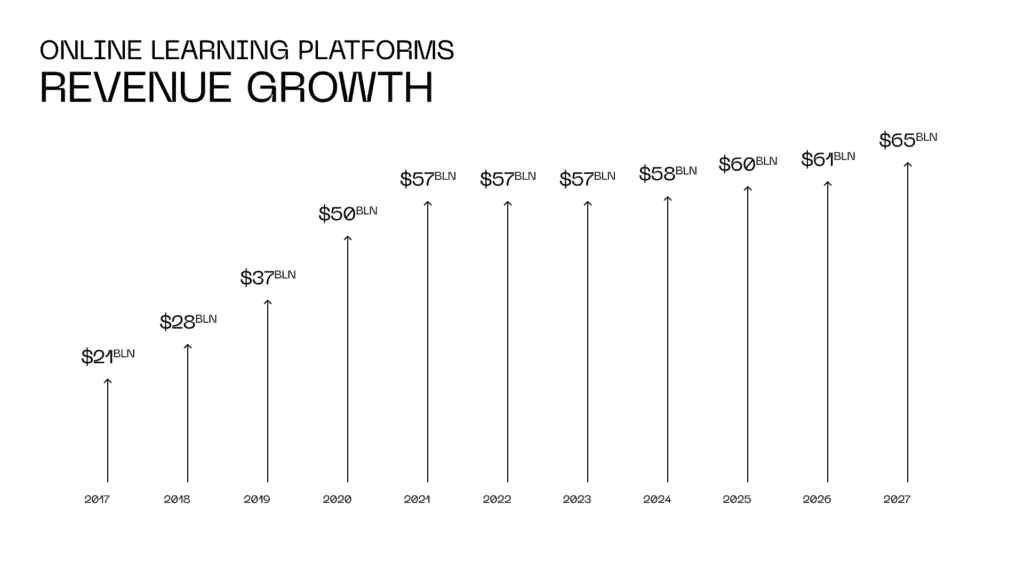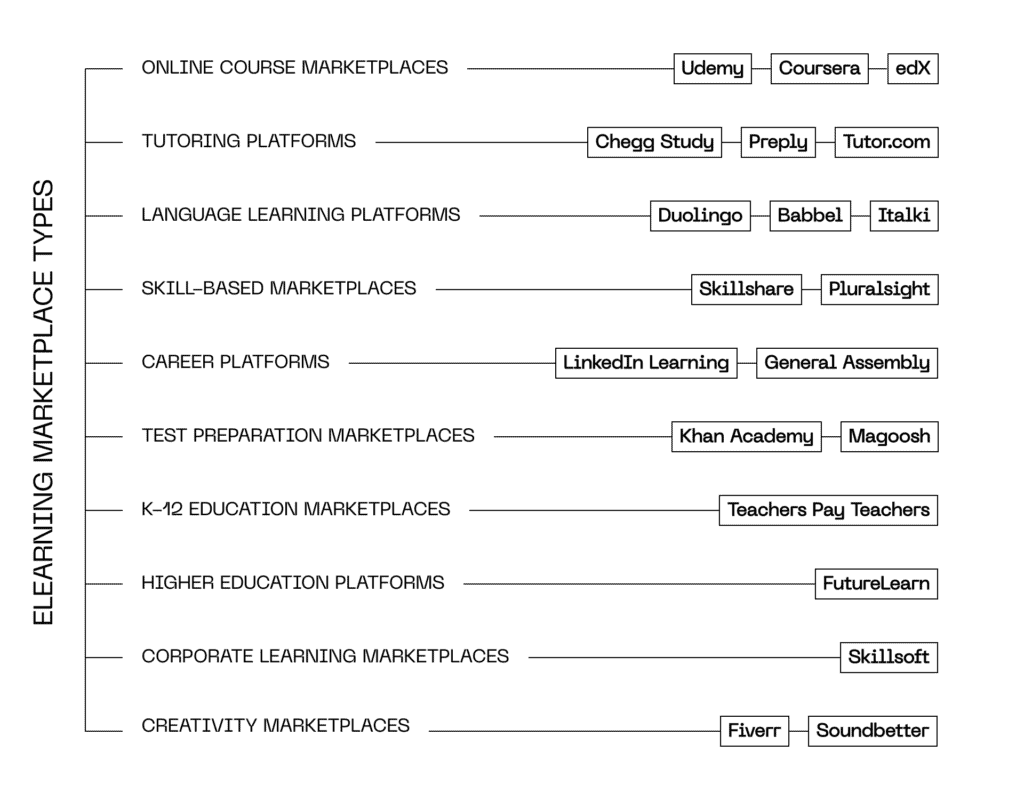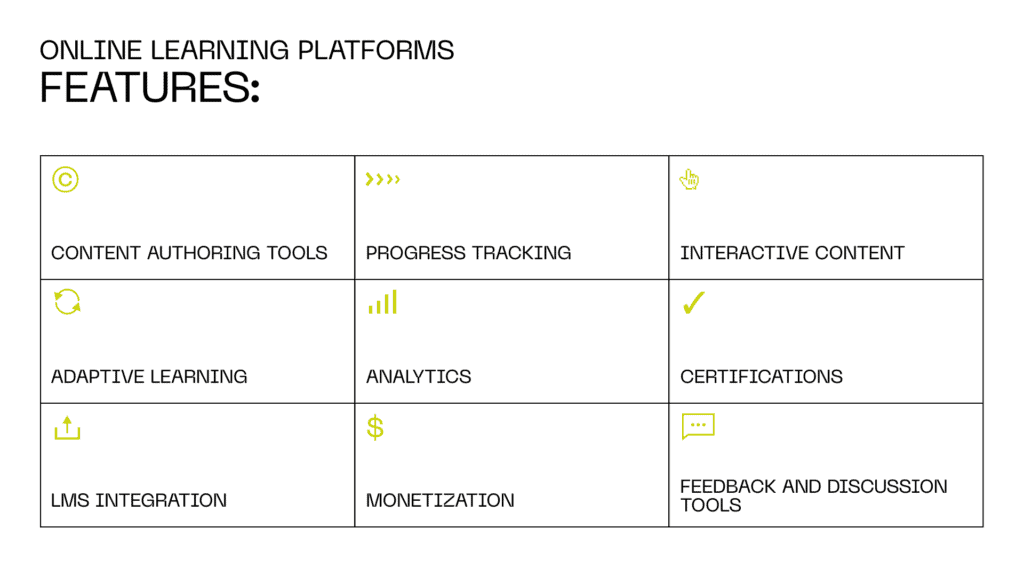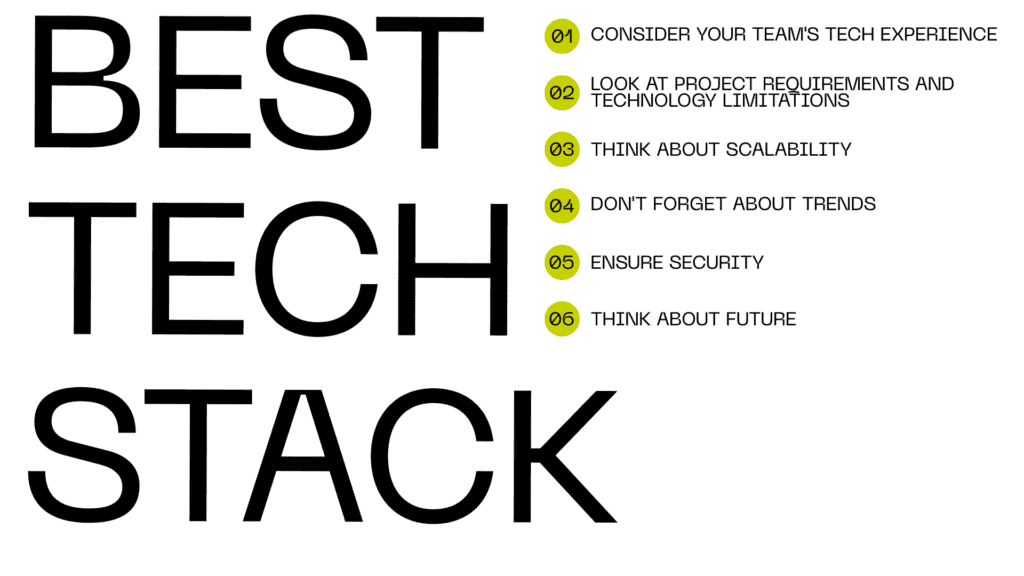Are you considering investing in an online learning marketplace? Now is a promising time.
Online learning is in high demand, with increasing enrollment in education programs and course purchases. This trend is expected to continue, as 96% of students have experienced a positive return on investment from online courses.
On the business side, the e-learning market is projected to achieve a steady annual growth rate of 3.22%, reaching $65 billion by 2027. Furthermore, 47% of schools have increased their spending on online programs.
In this post, we’ll guide you through the process of developing an e-learning marketplace from scratch, covering ideation to initial profits. We’ll also discuss popular features and technologies and recommend a monetization strategy. Let’s begin with some essential definitions for shared clarity.

What is an e-learning marketplace?
An e-learning marketplace, also known as an online education platform, serves as a hub where educators and content creators provide digital courses and educational materials for learners. This platform enables individuals to access and enroll in diverse educational resources presented in various formats.
Prominent e-learning marketplaces include Udemy, Coursera, SkillShare, and EdX, which offer a wide range of subjects. Additionally, niche educational platforms like MedYouCate cater to distinct audiences, such as medical students and practitioners. MedYouCate, by the way, was developed by the Syndicode team and has garnered recognition for its outstanding quality and execution.
Education marketplace types
- Online course marketplace
These e-learning software solutions offer various online courses on different subjects, often provided by individual instructors, educational institutions, or companies. Learners can enroll in courses of their choice and learn at their own pace. Udemy, Coursera, and EdX are the most prominent examples of online course platforms.
- Tutoring and learning support platforms
These marketplaces offer assistance in specific subjects or provide general academic support. They connect students with tutors and educators for one-on-one or group learning sessions. Examples include Chegg Study, Preply, and Tutor.com.
- Language learning marketplaces
These platforms focus on language education, providing courses, lessons, and language exchange opportunities. Duolingo, Babbel, and Italki are examples of language learning marketplaces.
- Skill-based marketplaces
These marketplaces cater to individuals seeking to acquire practical skills for personal development or career advancement. They offer courses and resources to help learners develop specific skills, such as coding, design, writing, or digital marketing. Skillshare and Pluralsight fall into this category.
- Career and professional development platforms
On these platforms, one can find courses, coaching, and resources to help learners advance in their careers, transition to new fields, or improve their professional skills. LinkedIn Learning and General Assembly are examples of such marketplaces.
- Test preparation marketplaces
These platforms focus on helping students prepare for standardized tests, entrance exams, and certifications. They offer study materials, practice tests, and resources to aid in test preparation. Khan Academy and Magoosh are examples of this category.
- K-12 education marketplaces
These marketplaces offer educational resources, lesson plans, teaching materials, and tools for educators working in K-12 classrooms. Teachers Pay Teachers is a prominent example.
- Higher education websites
Some software applications focus on connecting students with colleges, universities, and higher education institutions offering various degree programs and courses. These platforms may also provide resources for scholarship and financial aid information. FutureLearn can be categorized as an example of a higher education platform as it collaborates with universities and institutions to offer online courses, degrees, and micro-credentials across a range of subjects.
- Professional training and corporate learning marketplaces
These platforms cater to companies and organizations seeking to provide employee training and development opportunities. They offer courses and resources to enhance employee skills and knowledge. For example, Skillsoft provides e-learning solutions for corporate training, so it falls into this category.
- Music, art, and creativity marketplaces
These platforms connect learners with instructors or resources for creative pursuits like music lessons, art classes, and other artistic endeavors. Examples include Fiverr and SoundBetter for music-related services.

Steps to create an e-learning marketplace platform
As an experienced marketplace development services provider, Syndicode follows a proven process that optimally balances product quality and development resources. The outlined workflow is adaptable based on the product’s development stage.
1. Project discovery and estimation
We collaborate with the client to clarify project goals, purpose, and expectations. We also find it crucial to document key details about the product, current state, target market, success metrics, etc.
The main goals of the discovery stage include:
- Defining the goals and objectives of the e-learning business, such as the types of courses offered, target audience, and desired features.
- Conducting market research to understand user needs, competition, and trends.
- Defining the scope of the project, outlining main features and functionalities.
- Creating a project plan with timelines, milestones, and resource allocation.
- Assembling a cross-functional team of developers, designers, educators, and other relevant stakeholders.
As a result, both the client and the development team gain a clear vision of the product and can estimate the development costs and times. This proactive approach anticipates potential risks, facilitates mitigation strategies, and enhances development process efficiency.
You can learn more about the activities and documentation from the discovery stage in our earlier blog post, “Discovery session for the new project.”
2. Wireframes and UI/UX design
During this phase, the project team collaboratively envisions and outlines the evolving system. Here’s a brief overview of what happens:
- Wireframe and mockup development to illustrate the layout and structure of the platform’s user interface (UI).
- User experience (UX) design, including user flows, navigation paths, and interaction pattern creation.
- Visually appealing and intuitive UI design development that aligns with the platform’s branding and target audience.
- Designing the course catalog, user profiles, registration forms, payment processing, and other key components.
- Incorporating stakeholder feedback to refine the design and ensure a seamless user journey.
Syndicode’s UI/UX designers prioritize functionality and usability while delivering distinct, memorable experiences. You can find more insights into our UX/UI approach in our prior blog post about the “UX design pyramid.”
3. Product development
Transitioning from requirements and designs to functional code is the next phase in the education software development process. Software engineers execute the project’s functionality based on the delivery plan devised during the project discovery phase. This involves:
- Backend and frontend components development following approved designs.
- Feature implementation, including user registration and authentication, course creation and management, content delivery, discussion forums, assignments, assessments, and progress tracking.
- Third-party tools or services integration for analytics, payment processing, and communication.
- Testing and quality assurance to identify and fix bugs, errors, and performance issues.
- APIs or integration points development and testing in case the platform needs to connect with external systems or services.
Sometimes, preliminary testing is necessary before committing to a comprehensive product, and we opt for minimum viable product (MVP) development. In this case, the MVP development process largely mirrors the standard pattern, yet with certain modifications to accommodate limited resources.
4. Testing
Syndicode’s software testing process seamlessly integrates into the Software Development Life Cycle (SDLC). Each feature undergoes thorough checks before the team moves on to the next item in the delivery cycle. Here are the main activities for this phase:
- Deployment setup— we configure servers, databases, and hosting environments in preparation for deployment.
- Staging environment deployment by migrating the platform to a staging environment for conclusive testing and validation.
- User acceptance testing (UAT) to ensure alignment with user and stakeholder requirements.
- Feedback incorporation to address any final adjustments or enhancements based on UAT.
- Production environment deployment, enabling public access to the product.
5. Launch and post-launch activities
Post-launch, Syndicode’s commitment doesn’t end. Our team continues monitoring the system’s performance, providing ongoing refinement. Activities during this phase include:
- Performance monitoring, ensuring stability and optimal user experience.
- User feedback collection and analysis to identify areas for improvement and optimization.
- Iterative enhancements, updates, and new feature development based on user insights and evolving needs.
Ready to turn your e-learning vision into reality?
Achieve your dreams by partnering with Syndicode.
Contact usMust-have features of an e-learning platform
Educational websites and applications stand out from other marketplaces due to their specialized focus on providing tailored learning experiences. This distinctiveness is achieved by incorporating a variety of features that are typically exclusive to this category of platforms:
- Course structure and progress tracking. An e-learning marketplace should contain tools for structuring content into lessons, modules, or units, making it easy for learners to follow a learning path. Progress tracking features help learners see their advancement through the course.
- Content authoring tools allow teachers to create and update their courses.
- Interactive content and gamification, such as simulations, interactive quizzes, and virtual labs, enhance the learning experience and understanding.
- Adaptive learning features use data and algorithms to personalize the learning experience based on each learner’s progress and performance.
- Synchronous and asynchronous learning. E-learning platforms provide options for both synchronous (live) and asynchronous (self-paced) learning, accommodating different learner preferences.
- Learning analytics dashboard provides detailed insights into learner behavior, engagement, and performance. This data helps instructors and administrators optimize course content and delivery.
- Certification or other digital credentials to validate learners’ achievements.
- Discussion boards and collaborative learning tools facilitate peer review and peer-to-peer interaction, allowing learners to chat, ask questions, and collaborate.
- Learning Management System (LMS) integration, including tools for enrollment, grade tracking, and content management, provides a more comprehensive educational environment and is a common feature of e-learning platforms.
- Content monetization. E-learning platforms frequently offer options for instructors or content creators to monetize their courses by setting pricing, offering subscriptions, or implementing pay-per-course models.
- Accessibility and universal design help prioritize accessibility features to accommodate learners with disabilities, ensuring a more inclusive learning experience.
- Live virtual classes. Some e-learning platforms offer live virtual classes, webinars, or office hours to facilitate real-time interaction between instructors and learners.

Features of top famous e-learning marketplaces
Considering building an e-learning marketplace platform like Udemy? Let’s see what unique features set apart these major players in the global education market.
Udemy
Udemy is an open-source learning platform that allows users to become instructors, upload courses, and earn from enrollments. It offers a wide range of pay-per-course topics and also features a corporate portal for tailored employee skill training.
Key distinguishing features of Udemy include:
- Diverse course base: Udemy hosts courses on virtually any subject;
- User-generated content;
- Lifetime access to courses;
- Self-paced learning;
- User reviews and ratings;
- Money-back guarantee;
- Mobile app;
- Free course previews;
- Learning paths: curated collections of courses on a specific field or career related to the learner’s learning history;
- Certificate of completion.
Udemy’s impact is evident, with 57 million users and nearly $500 million in annual revenue.
Coursera
Coursera, an online learning services provider, collaborates with educational institutions to offer diverse learning materials. It hosts subscription-based courses, specializations, and degrees spanning numerous subjects. This eLearning platform also facilitates skill-based learning for businesses and government entities.
Its distinctive features comprise:
- Top universities and instructors: partnerships with prestigious universities and institutions around the world offer learners access to high-quality content and instruction from experts in their respective fields;
- Flexible learning formats;
- Specializations—curated sequences of courses that allow learners to delve deeper into a specific topic and gain a more comprehensive understanding of a subject area;
- Degrees and MasterTracks allow learners to earn formal degrees or credentials from accredited institutions entirely online;
- Peer assessment and grading;
- Language support makes the platform accessible to learners from different parts of the world;
- Financial aid and scholarships for those who may not have the means to pay for courses;
- Coursera for Business allows companies and organizations to provide training and professional development for their employees through the platform;
- Mobile e-learning app.
Coursera has amassed 100 million users and collaborates with over 275 universities and companies. The platform generates annual revenue surpassing $300 million.
EdX
EdX is another popular online learning platform that offers a variety of courses, programs, and degrees from universities and institutions worldwide. It employs a pay-per-program approach for individuals and offers business subscriptions for tailored courses.
Notable features that distinguish EdX include:
- Free course audit option allows users to access course materials without receiving a certificate at the end;
- MicroMaster programs allow users to earn credentials in a specific skill or field;
- Verified certificates;
- Flexible learning options;
- Discussion forums and peer interaction;
- Open EdX platform allows institutions and organizations to create their own online learning environments and deliver courses;
- Courses in a variety of languages;
- Honors and badges to popular courses to motivate learners;
- EdX for Business—corporate learning solutions;
- Instructor-led courses;
- Learner analytics.
As of this writing, EdX boasts 76 million users and an estimated annual revenue of approximately $120 million.
Struggling to choose features for your e-learning platform?
Syndicode’s experts will help you make an optimal decision considering your target market, competition, resources, and technical feasibility.
Contact usTechnologies to create an online education marketplace
Selecting the right technologies to build an online education platform is one of the most crucial things to ensure a robust, scalable, and user-friendly solution. The choice of technologies depends on various factors, including your platform’s features, scalability requirements, development expertise, and budget.
Here are the top popular technologies for e-learning marketplace development in 2023:
1. Backend technologies
- Programming languages: Common choices include Python (Django, Flask), Ruby (Ruby on Rails), PHP (Laravel), Java (Spring Boot), and Node.js. Choose a language that your development team is comfortable with and that aligns with your platform’s requirements.
- Databases: Relational databases like PostgreSQL and MySQL are often used for data storage. NoSQL databases like MongoDB may be suitable for specific use cases.
- API development: Building a robust API is crucial for e-learning platforms. Technologies like GraphQL or RESTful APIs can be used to facilitate communication between frontend and backend components.
2. Frontend Technologies
- JavaScript frameworks: Popular choices include React, Angular, and Vue.js. These frameworks enable dynamic and interactive user interfaces.
- UI Libraries: UI libraries like Bootstrap or Material-UI can help streamline the frontend design process and ensure a consistent user experience.
- CSS Preprocessors: Tools like Sass or Less can help manage and enhance your platform’s CSS styles.
3. Content Management System (CMS)
- WordPress is a good and affordable option for content management.
- Custom CMS development may be necessary if your e-learning platform involves significant content management, blogging, or dynamic content.
4. Video streaming and hosting
- For hosting and streaming video content, consider platforms like Vimeo, YouTube, or specialized video streaming services.
5. Cloud services
- Cloud providers like Amazon Web Services (AWS), Microsoft Azure, or Google Cloud Platform can offer scalable infrastructure, storage, and computing resources.
6. Authentication and security
- Implement secure user authentication using technologies like OAuth, JWT (JSON Web Tokens), or third-party authentication providers like Google or Facebook.
7. Real-time communication
- If your platform requires real-time communication, consider integrating technologies like WebSockets for interactive features and notifications.
- Analytics and tracking
- Use analytics tools like Google Analytics or Mixpanel to track user behavior, engagement, and course performance.
Read also: React vs. Angular: Choose the Best Framework for Your Next Project

Other things to consider when building an e-learning platform
Platform choice
Should you launch your e-learning platform as a web-only version, a web app, a mobile app, or a cross-platform solution? The choice will depend on various factors, including your target audience, budget, development timeline, and long-term goals. Each option has its own set of pros and cons. Here’s a comparison to help you decide under which conditions one might be better than another:
| Pros | Cons | |
| Web-only version | Wider reach as it can be accessed by users on various devices Lower development costs Faster deployment | Limited mobile experience and accessibility due to limitations in utilizing device-specific features |
| Mobile app | Enhanced user experience due to the use of device-specific features Brand presence due to having an app icon on users’ devices Push notifications | Higher development costs Longer development time |
| Web app | Cross-platform compatibility Easier updates | Potential for slower performance |
| Cross-platform solution | Unified development Time and cost savings due to a single codebase | Wider reach as users on various devices can access it Lower development costs Faster deployment |
Considering the strengths and weaknesses of each approach, our recommendation is as follows:
- A web-only version should be prioritized in case you want to reach a wide audience quickly and have budget or time constraints. It allows for rapid deployment and access across various devices.
- Native mobile app development is a suitable first choice if you prioritize a superior customer experience, have the budget and resources, and want to leverage device-specific features.
- A web app is a viable choice if you seek a balance between cross-platform accessibility and better user experience compared to a purely web-based solution.
- A cross-platform solution is beneficial if the goal is to reach both iOS and Android users while minimizing development efforts and costs, especially if performance differences are acceptable for your use case.
Monetization strategy
1. Course fees or enrollment charges
Many online education marketplaces charge learners a fee to enroll in individual courses or complete a full program. Usually, this entails life-long access to the purchased course. Udemy uses this business model, charging from $19.99 to $199.99 per course and getting an average revenue per buyer of $20, as seen from the latest statistics.
2. Subscription model
A subscription-based model provides learners access to a library of courses or premium content for as long as they keep their subscriptions active. This revenue generation model has increased in popularity over the last few years.
3. Paid certificates (Freemium model)
Some platforms offer free course access but charge a fee for issuing verified certificates that learners can add to their resumes. Research revealed that a single program could bring around 49K active learners that paid, on average, $50 each for a certificate for some 1,5 years.
4. Corporate and B2B sales
Businesses and organizations often seek customized training solutions for employee training and professional development. Education platforms offer that opportunity and charge a premium for corporate accounts based on the number of users or specific features. About half of Udemy’s revenue comes from the B2B sector, and recently, this revenue channel has exceeded the B2C one for the first time.
5. Other revenue strategies
Less popular, although still effective, monetization opportunities include:
- Charging fees for course creation from authors
- Engaging in affiliate marketing
- Providing consulting services or one-on-one coaching sessions.
Payment system selection
When setting up an e-learning application, selecting the right payment system is crucial to ensure smooth and secure transactions for users. There is a variety of payment gateway providers and aggregators on the market, the most popular of them being Stripe, PayPal, Authorize.net, and Payoneer.
When choosing the best payment solution for your education marketplace, we recommend considering the following factors:
- Security and compliance with PCI-DSS to protect user data and financial information;
- Customer experience: a payment system must provide a seamless and user-friendly checkout process for learners, helping reduce friction and cart abandonment;
- Supported payment methods: the more payment methods are supported, the better. This includes credit/debit cards, digital wallets, and other regional options.
- Integration and APIs: Look for developer-friendly APIs and documentation to ensure the payment system integrates well with your online education platform’s technology stack.
Syndicode’s experience in e-learning platform development
As a globally trusted software development services provider, we approach clients’ projects with the same dedication we’d invest in our own. Striving to build an excellent product, we meticulously analyze ideas and select optimal technologies for implementing desired functionalities. As a result, most of our clients entrust us with ongoing maintenance and development services post-launch.
One of our recent projects is MedYouCate, an e-learning platform tailored for healthcare learners. It offers high-quality videos in two languages and a user-friendly creator studio interface that ensures comprehensive course creation following medical education standards.
Check out our featured projects for more of what we’ve done
Syndicode specializes in marketplace development, meaning we know everything about it.
See projectsReady to build a ground-breaking e-learning platform?
The e-learning industry is projected to thrive over the coming decade. While major players like Coursera and Udemy excel in general subjects, the demand for specialized training remains high. So, if you have a niche-focused concept, the time is ripe to seize the opportunity.
Hopefully, this article has given you an idea of what kind of e-learning platform to go for and what to expect from your partnership with a development company. If you have any questions we haven’t covered in our blog, feel free to request a consultation using the contact form. Outline your problem, and we will reply in less than 24 hours with possible solutions!
Frequently Asked Questions
-
How long does it take to create an e-learning marketplace?
The time it takes to create an e-learning marketplace can vary widely based on factors such as the complexity of the platform, the scope of features, the size of the development team, and the level of customization required. Here’s a general overview of the key stages and their potential durations; note that the actual timeline may differ for your specific project: 1. Planning and research—2-4 weeks; 2. Design and prototyping—4-8 weeks; 3. Frontend and backend development—8-16 weeks or more; 4. Content creation and onboarding—4-12 weeks or ongoing; 5. Testing and quality assurance—4-8 weeks; 6. Launch and deployment—2-4 weeks; 7. Post-launch iteration and enhancement—ongoing. To sum it up, it may take 24-52 weeks and more, depending on the platform complexity, customization requirements, team size, and unforeseen challenges. Collaborating with an experienced development team, setting clear goals, and maintaining effective communication throughout the process can help streamline development and ensure a successful launch of your e-learning marketplace.
-
How much does it cost to make an e-learning marketplace?
It’s challenging to provide an exact cost to build an educational marketplace as it can vary widely based on a range of factors, including the platform’s features, complexity, design, development approach, technology stack, team size, geographic location, and more. A general breakdown of the key cost components and factors that influence the overall expense are 1. Development team’s salaries; 2. Technology and infrastructure expenses; 4. Features and functionality building costs, including integrating third-party services, APIs, or plugins; 5. Content creation and management costs; 6. Quality assurance and testing expenses; 7. Marketing costs; 8. Post-launch maintenance expenses. Given the wide range of variables, we recommend consulting with experienced developers, project managers, or technology experts to get a more accurate estimate for your specific e-learning marketplace project. Keep in mind that developing an online marketplace is an investment, and focusing on delivering a high-quality platform that meets user needs and provides value can lead to long-term success and a strong return on investment.
